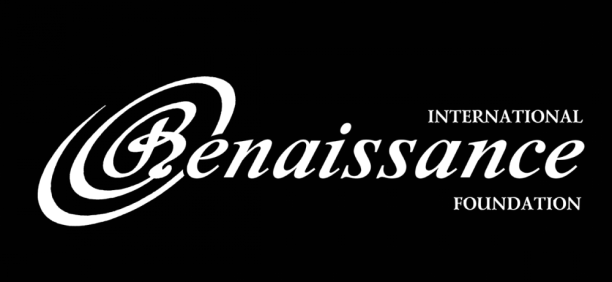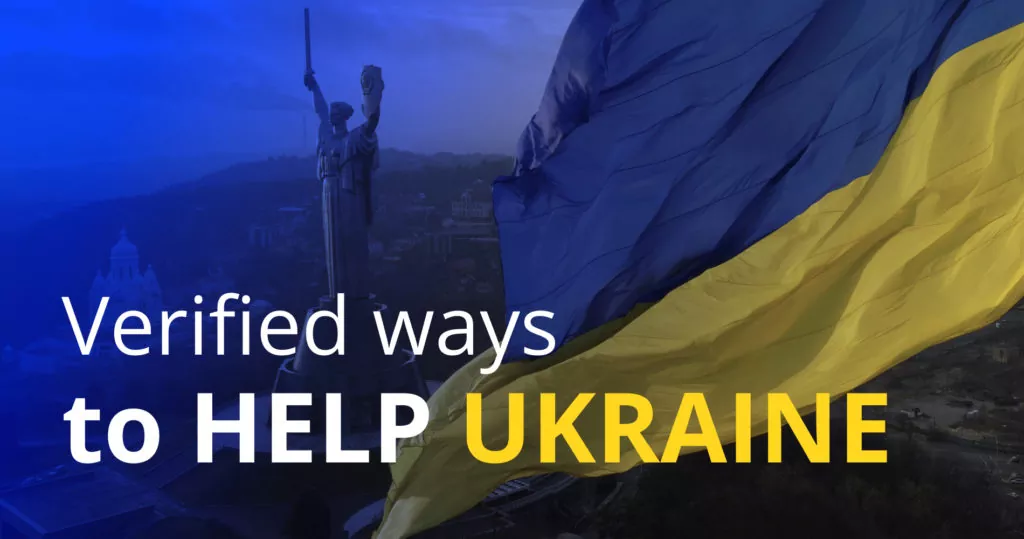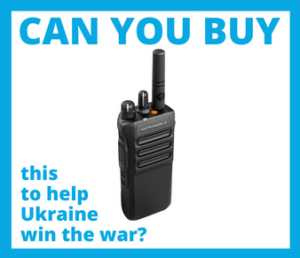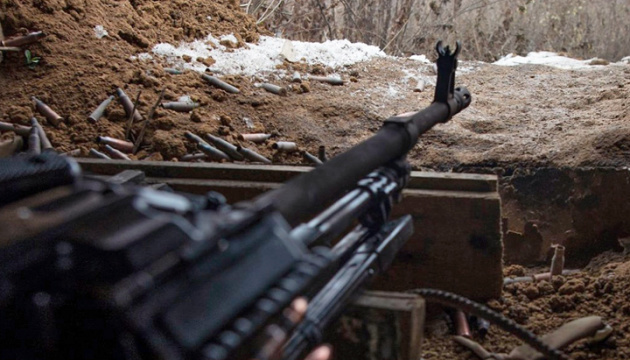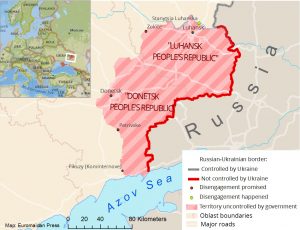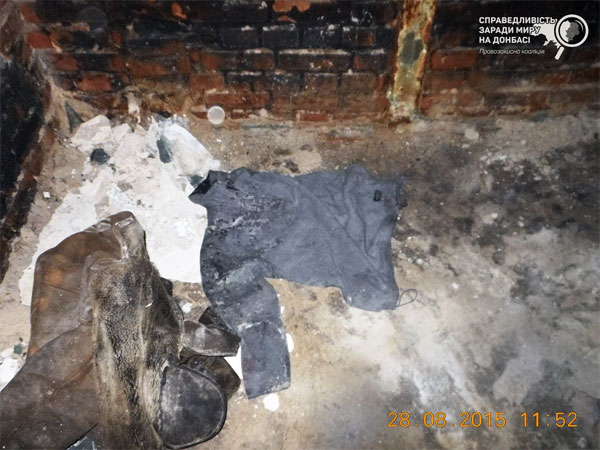Last week amid a string of strange disparate events in the country, Ukrainian president Zelenskyy announced another ceasefire in eastern Ukraine as the Trilateral Contact Group (TCG) on resolving the conflict agreed on another truce in Ukraine’s war-torn Donbas region at their online meeting.
The text of the approved document that surfaced online and later proved to be valid showed that this time the negotiators went beyond standard prohibitions and banned any intelligence activities including using drones, any fire including sniper fire, meanwhile, the soldiers who violate the truce should be punished and the TCG should be informed about the measures applied to the violators.
Zelenskyy’s second ceasefire
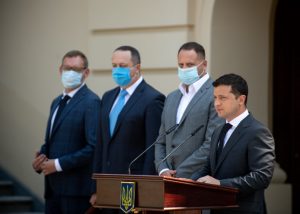
One of the points of Zelenskyy’s rhetoric at his presidential campaign a year ago was “stopping the war” in Donbas which exploited a popular belief incepted by Russian propaganda and bolstered by local activists and the press – that the country’s leadership profiteered from the war and therefore was reluctant to stop or even end it.
Each of more than 20 ceasefire attempts throughout the six years of war decreased military activities at the front for a short period of time yet never fully suspended hostilities keeping the conflict far from being frozen at any given time.
As Zelenskyy showed his readiness to negotiate the Russian propositions, Russia returned to the shelved Normandy Format of the Donbas talks between leaders of Ukraine, Russia, France, and Germany by the end of 2019 which resulted in signing a document in Paris to impose the measures in order to settle the conflict which included a ceasefire and the prisoner swap.
Two exchanges of prisoners actually took place, yet not without controversial steps from the Ukrainian side, which released and handed over the operatives from the special police unit Berkut tried in Ukraine for suspected involvement in mass killings of the Euromaidan activists in 2014. However, the Paris ceasefire failed and the Ukrainian casualties in the first month of the supposed truce, January 2020, amounted to at least 16 killed servicemen.
Now, Zelenskyy said that the newly-agreed truce will be sustainable and called on the leaders of the Normandy Four to sign the document as well.
On the eve of the ceasefire, the tone of Ukraine’s Joint-Forces Operation press service daily communiqués changed from the usual wording “the armed forces of the Russian Federation violated the ceasefire [certain number of] times” to
“On the previous day, no enemy fire attacks were recorded in the areas of responsibility of the vast majority of [Ukrainian] units. With the exception of 15 violations of the ceasefire in the settlements of Krymske, Prychepylivka, Popasna, Troitske, Novozvanivka, Novooleksandrivka, Orikhove, Avdiivka, Nevelske, Lebedynske, Opytne, and Vodiane,” the 26 July JFO press release reads.
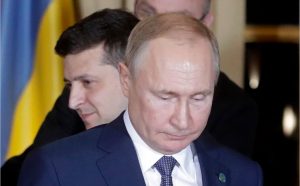
On the same day a few hours before the ceasefire took effect, Zelenskyy had a phone conversation with Russian President Vladimir Putin. The Office of the Ukrainian president stated that,
“The interlocutors welcomed the achievement of an agreement on a full and comprehensive ceasefire regime in the Donbas, which begins at 00:01 on 27 July 2020, the President of the Russian Federation supported this agreement.”
However on the next day Dmitry Peskov, the spokesperson of the Russian president, once again repeated Russia’s 6-year long mantra that the Russian Federation isn’t a side to the conflict in the Donbas and can’t give any guarantees.
“[The ceasefire] is a very significant and positive step towards strengthening mutual trust and easing tensions on the line of contact,” Peskov said, “it will be important that both parties fully adhere to their obligations and agreements,” he added, implying that Ukraine should conduct direct talks with the so-called People’s Republics of Donetsk and Luhansk (“LDNR”).
Another stillborn truce?
The announced ceasefire came into effect at midnight overnight into 27th July. However, it took only 20 minutes for the Russian forces to run their first fire attack on the Ukrainian positions, according to the JFO command. Another attack from the Russian side took place around 9 a.m., according to the JFO.
The OSCE Special Monitoring Mission spotted the military activity only at 9:45 up until 11:35, recording over 100 counts of the violations which included 25 separate shots of small arms, 65 bursts, and 21 undetermined explosions:
“Following the meeting of the Trilateral Contact Group on 22 July, which reached agreement regarding additional measures to strengthen the ceasefire as of 00:01 on 27 July, the SMM recorded 111 ceasefire violations, all in Donetsk region, including 21 explosions,” the summary of the daily report reads.
The JFO, that counts rather periods of military activity than OSCE SMM’s recording of separate instances of the use of weapons, reported on three ceasefire violations in total throughout 27 July.
On the evening of 27 July, the Capitulation Resistance Movement, a non-partisan public association, gathered a rally near the presidential office. The protesters believed that the truce plan disarms the Ukrainian army by forbidding firing back and conducting intelligence activities which leaves the army blind in the conditions of war, meanwhile, resistance to the aggressor might lead to disciplinary responsibility. The protesters also opposed Russia carrying no responsibility in the truce, which legitimizes its proxy LDNR statelets.
Ukrainian leadership believes in the current ceasefire
On the second day of the truce, Oleksii Reznikov, the Minister for the Reintegration of the Temporarily Occupied Territories, commented on the situation saying,
“I am convinced that this is a violation of the regime of silence (one of the Ukrainian synonyms for ‘ceasefire’, – Ed.), not [a violation of] the ceasefire because a set of additional measures involves conducting an appropriate inspection, investigation of actions by violators and informing the OSCE SMM, which, in turn, should inform the Trilateral Contact Group on the cause of such a violation, the fact of resumption of firing.”
On 29 July, the Commander-in-Chief of the Ukrainian Armed Forces, Ruslan Khomchak explained to President Zelenskyy that the ceasefire is being implemented on both sides, and “isolated cases” of its violation are not systemic and stressed that no one was injured or killed since the ceasefire came into effect.
Zelenskyy himself gave the following comment yesterday,
Can we say that we have agreed on a ceasefire? Yes. Can we say that there are no single shots? No. They are… As for the other side [euphemism for the Russian occupation authorities if Luhansk and Donetsk, – Ed], everything will depend, I am sure, on the Russian Federation, whether it will be able to control everything as well and whether they will be able to adhere to the agreements that we had. We’ll see. If that side really wants an end to the war, which they keep talking about, we will feel it, that’s it.”
The Joint-Forces Operation press service states that the ceasefire is observed and there was only one under-barrel grenade launcher (UBGL) shot recorded throughout 28 July. Meanwhile, even the OSCE SMM spotted four explosions in two different locations in Donetsk Oblast on 28 July.
On 29 July there was at least one report from local residents on Facebook on possible military activity in the south of Donetsk Oblast, reposted on Twitter by one of the accounts monitoring the situation in the Donbas, it reads,
“#Bezimenne [occupied, 25 km east from central Mariupol]. Salvos all day. Most probably [coming] from the western direction.”
On the fourth day of the ceasefire, 30 July, the JFO reported two enemy attacks that involved small arms, both in Luhansk Oblast.
The OSCE SMM recorded only one explosion on 29 July and, the report says it occurred in the Mariupol area near the government-controlled village of Lebedynske which lies some 10 kilometers away from Bezimenne. The JFO also mentioned only one ceasefire violation on 29 July, however, it was a UBGL shot that occurred on the other end of Donetsk Oblast, near Novoluhanske.
Reports started circulating on the death of one Ukrainian soldier, Artur Bakhnar, in Novohnativka south of Donetsk on 28 July. Both JFO and OSCE SMM, however, didn’t report on any military activity in the area on that day, and it is unknown whether his death might have been caused by the attacks. As this anecdotal information gained traction on social media, the JFO press service came up with an official account that, in fact, there were three soldiers who died since the beginning of the truce and, the agency states, they all died due to “a sharp deterioration in their health,”
“The Joint Forces Command sadly reports that since the beginning of the week, we have lost three devoted patriots and courageous defenders of Ukraine who have died as a result of a sharp deterioration in their health. On July 28, the heart of soldier Arthur Bakhnar stopped beating, and on July 29, the life of soldier Serhiy Verhun ended. And today Ukraine lost another defender – Senior Sergeant Volodymyr Perekrestov,” the JFO message reads.
Read more:
- Vitaly Portnikov: Russia has no intention of adhering to the upcoming ceasefire agreement
- Bloody week in the war zone: war crimes and military incompetence
- Kremlin lambastes alleged Ukraine’s deviations from Minsk and Normandy processes
- No end to Russia’s war until Kremlin achieves goals in Ukraine
- Troop disengagements with Russia work only after capitulation to Russia: lessons from Georgia and Moldova
- “Steinmeier’s formula” seen as state capitulation, protested in Ukraine
- Zelenskyy’s first Normandy and the illusion of progress
- Everything you wanted to know about the Minsk peace deal
- Another ceasefire begins in Donbas after pullout of Russian observers followed by escalation (2017)
- Avdiivka. Have you heard about the ceasefire? (2016)
- No one in the Donbas believes the ceasefire will last (2016)
- Russia’s new strategy in Ukraine: no ceasefire before allowed to dictate constitution (2015)
- Ceasefire broken? (2015)
- Regular Russian forces attack Ukrainian army in Donbas amid so-called “ceasefire” (2015)
- Phoney war in Donbas. Who gained from the ‘ceasefire’? (2014)
- Ceasefire Ceased: How the terrorists ended the truce (2014)

